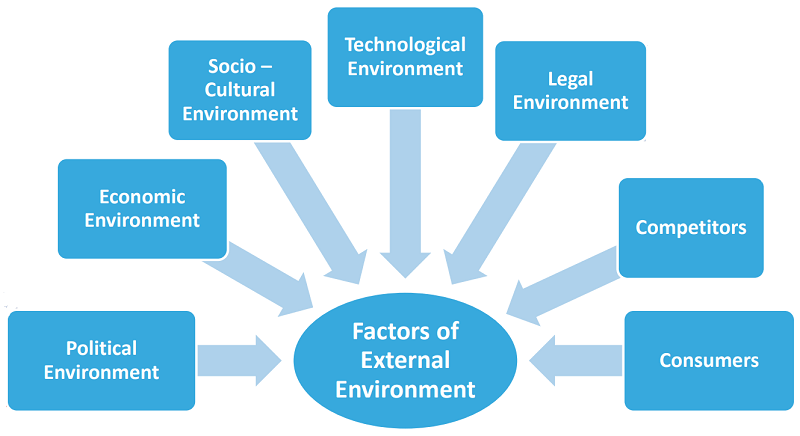Learn more about the External Environment (Micro and Macro) and various models/tools available to carry out External Analysis.
External Environment
The external environment comprises of all external (outside) factors or influences that has could potentially impact the operation of a business.
There are large external environmental forces affecting the industry in which a business operates.
These are factors over which a business usually does not have much control, but managers must keep an eye on how the environment is changing so that they can plan for its impact on their business.
These factors could provide opportunities that can be exploited by a business to gain market leadership, and also presents threats such as obsolescence due to emerging products and technology, and threats due to other restrictions on the business.
Factors of External Environment include Political Environment, Economic Environment, Socio-Cultural Environment, Technological Environment, Legal Environment, Competitors, Consumers.
The external environment can further be divided into:
Micro (or Intermediate) environment
These are the forces in the immediate environment including of the firm. that have an interest in the organization. Actors within this environment are suppliers, distributors, customers, competitors, and other stakeholders or interest groups; these have the ability to impact business.
The micro environment is semi-controllable by the organizations.
Relevant variables to be considered as part of External Micro Analysis could be:
- Market size, Market growth rate, Market potential
- Availability of customer segment (segmentation variables: demographic, psychographic, geographic, etc.)
- Buying power of consumers
- Level of competition
- Ability to create competitive advantage
- Ease of market access/entry regulations
- Average industry margin
- Product/business model compatibility (to what extent is adaption of marketing mix required)
- Strategic importance of the market (first mover advantage, must win market)
As the company engages in global business activities, these actors can be relevant in the home/domestic market as well as in the host/foreign markets where company conducts business internationally. All these actors have to be taken into account when planning and strategizing as a global company.
Macro (External) environment
These are larger societal forces, often outside of the business’ control, that affects the microenvironment. These are typically of a larger scale and affects the entire industry.
The macro environment is not controllable by the organizations but factors within this environment have to be taken into account when planning and strategizing as a company.
For global firms, these factors can be relevant in the home/domestic market as well as in the host/foreign markets where company conducts business internationally.
These factors relate to:
- Political Environment/factors that affect business
- Legal Environment/factors
- Economic Environment facing Business
- Socio-Cultural Environment/factors that affect business
- Technological Environment: Impact on business
External Analysis Models / Tools
PESTLE Analysis
PESTLE analyses macro-level external factors categorized as POLITICAL, ECONOMIC, SOCIAL, TECHNOLOGICAL, LEGAL, ENVIRONMENTAL.
Porter’s Five Forces
SWOT Analysis
Related: Strategic Analysis and Formulation
References
Türkay, O., Solmaz, S.A. and Şengül, S. (2011). Strategic Analysis of the External Environment and the Importance of the Information: Research on Perceptions of Hotel Managers. Procedia – Social and Behavioral Sciences, [online] 24, pp.1060–1069. Available at: https://www.sciencedirect.com/science/article/pii/S1877042811016314.
BATheories.com is managed by a group of educators from Mumbai. We also manage the website AcademicsHQ.com. Our panel includes experienced professionals and lecturers with a background in management. BATheories is where we talk about the various business theories and models for BA (Business Administration) students.
